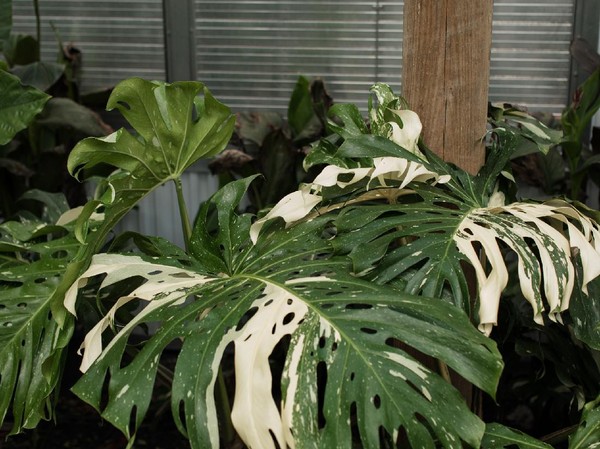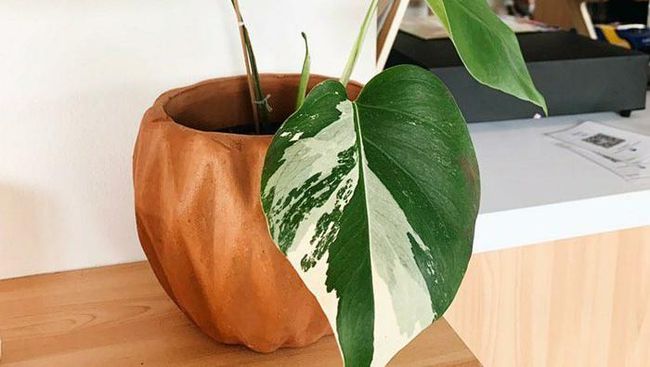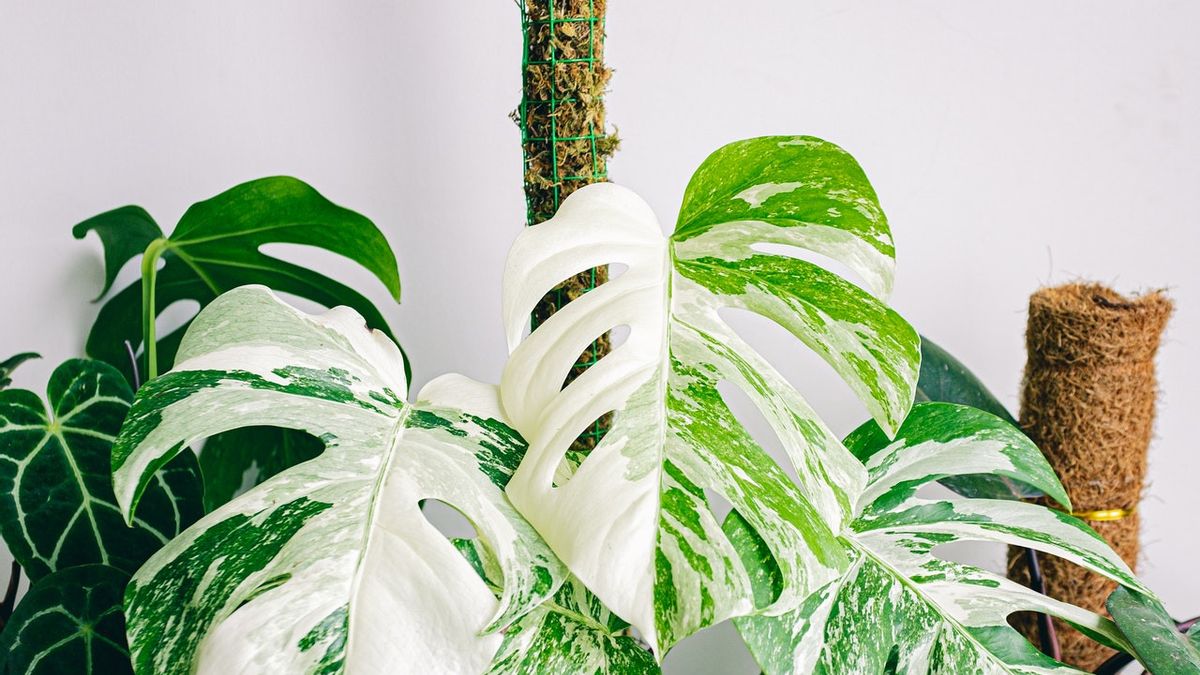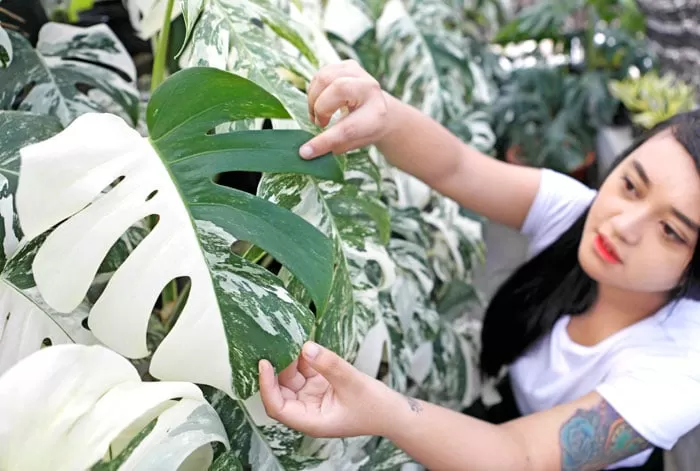Monstera Variegata, also known as Variegated Monstera, is a captivating and sought-after variety of the popular Monstera Deliciosa plant. Known for its strikingly beautiful leaves marked with patches of white or cream, Monstera Variegata has become a prized possession among plant enthusiasts and collectors. This article delves into the origins, characteristics, care requirements, propagation methods, and the cultural significance of Monstera Variegata, shedding light on why this plant is so cherished.

Origins and Characteristics Monstera Variegata
Monstera Deliciosa, the parent plant of Monstera Variegata, is native to the tropical rainforests of Central and South America. The plant thrives in the warm, humid undercanopy of these forests, where it climbs trees and spreads its large, fenestrated leaves to capture sunlight. The variegated variety, however, is a rare genetic mutation that occurs naturally in the wild but is more commonly propagated through human intervention.
Distinctive Variegation
The defining characteristic of Monstera Variegata is its variegation – the presence of white or cream-colored patches on its leaves. This variegation is caused by a lack of chlorophyll in certain parts of the leaf, resulting in a stunning contrast between the green and white sections. Each leaf is unique, with the pattern and amount of variegation varying from one leaf to another. Some leaves may have large white sections, while others may display a more marbled appearance.
Growth Habit
Monstera Variegata shares the same growth habits as its non-variegated counterpart. It is a climbing plant that uses aerial roots to attach itself to trees or other structures. In indoor environments, it is often grown with the support of a moss pole or trellis to encourage vertical growth. The plant can reach impressive heights, with leaves that can grow up to 3 feet long in ideal conditions.
Care Requirements
Monstera Variegata requires specific care to maintain its health and vibrant variegation. While it shares many care requirements with Monstera Deliciosa, there are some additional considerations due to its variegation.
Light
Adequate light is crucial for Monstera Variegata. The plant thrives in bright, indirect light but can tolerate some direct sunlight, especially in the morning or late afternoon. Variegated leaves have less chlorophyll, which means they are less efficient at photosynthesis. Therefore, providing sufficient light is essential to support the plant’s growth and maintain its variegation. However, too much direct sunlight can scorch the leaves, so it is best to avoid placing the plant in harsh, midday sun.
Watering
Watering needs for Monstera Variegata are similar to those of other Monstera plants. The soil should be kept consistently moist but not waterlogged. It is important to allow the top inch of soil to dry out between waterings to prevent root rot. Using well-draining soil and a pot with drainage holes can help manage moisture levels. In the growing season (spring and summer), the plant may require more frequent watering, while in the dormant season (fall and winter), watering can be reduced.

Humidity
Monstera Variegata, like its tropical relatives, thrives in high humidity. Aim to maintain a humidity level of at least 60%, though higher levels are beneficial. If indoor humidity is low, using a humidifier, placing the plant on a pebble tray filled with water, or regularly misting the leaves can help increase humidity around the plant.
Temperature
Ideal temperature ranges for Monstera Variegata are between 65°F and 85°F (18°C to 29°C). The plant is sensitive to cold and should be kept away from drafts, air conditioning vents, and temperatures below 55°F (13°C).
Fertilizing
Regular fertilization during the growing season can promote healthy growth and vibrant variegation. Use a balanced, water-soluble fertilizer every 4-6 weeks from spring to summer. Reduce or eliminate fertilization during the fall and winter months when the plant’s growth slows down.
Propagation Monstera Variegata
Propagating Monstera Variegata can be yowestogel challenging but rewarding. The most common methods are stem cuttings and air layering.
Stem Cuttings
- Select a Healthy Stem: Choose a healthy stem with at least one node (the point where leaves and aerial roots emerge) and a leaf. The presence of variegation on the cutting is crucial to ensure the new plant will also display variegation.
- Cut and Prepare: Using a clean, sharp knife or scissors, make a cut just below a node. Remove any lower leaves to expose the node.
- Rooting in Water: Place the cutting in a jar of water, ensuring the node is submerged. Change the water regularly to keep it fresh and oxygenated. Once roots are about 2-3 inches long, the cutting can be planted in soil.
- Rooting in Soil: Alternatively, the cutting can be planted directly in a pot with well-draining soil. Keep the soil moist and maintain high humidity to encourage root development.
Air Layering
- Select a Stem: Choose a healthy, variegated stem with a node.
- Make an Incision: Make a small, upward-slanting cut on the stem below the node. Be careful not to cut all the way through the stem.
- Apply Rooting Hormone: Apply rooting hormone to the incision to promote root growth.
- Wrap with Moss: Wrap the incision with moist sphagnum moss and cover it with plastic wrap or aluminum foil to retain moisture.
- Monitor and Wait: Keep the moss moist and check periodically for root development. Once roots are visible through the moss, cut the stem below the new roots and plant it in soil.
Cultural Significance and Popularity

Monstera Variegata has gained immense popularity among plant collectors and enthusiasts due to its rarity and striking appearance. Its unique variegation makes it a standout piece in any plant collection, and its demand has surged in recent years, often commanding high prices in the market.
Symbolism and Aesthetics
In addition to its visual appeal, Monstera Variegata is often associated with positive symbolism. The plant represents growth, prosperity, and resilience, making it a popular choice for home décor and interior design. Its large, fenestrated leaves add a tropical touch to indoor spaces, creating a sense of tranquility and natural beauty.
Challenges and Considerations
While Monstera Variegata is a stunning addition to any plant collection, it does come with certain challenges:
- Rarity and Cost: The rarity of Monstera Variegata makes it more expensive and harder to find compared to other houseplants. Collectors should be prepared for the investment and potential difficulty in sourcing a healthy plant.
- Maintenance: Maintaining the variegation and overall health of the plant requires careful attention to light, humidity, and watering needs. Variegated leaves are more prone to damage from direct sunlight and nutrient deficiencies.
- Propagation Difficulties: Propagating Monstera Variegata can be challenging, especially for beginners. Success rates may vary, and patience is required to see new growth and variegation in propagated plants.
Conclusion Monstera Variegata
Monstera Variegata is a captivating and exquisite houseplant that brings a touch of tropical elegance to any space. Its unique variegation and striking foliage make it a highly sought-after plant among enthusiasts and collectors. While it requires specific care and attention, the rewards of nurturing this rare beauty are well worth the effort. As the popularity of Monstera Variegata continues to grow, so does its cultural significance and appreciation as a symbol of growth and natural beauty. Whether you’re a seasoned plant collector or a novice enthusiast, adding a Monstera Variegata to your collection is sure to bring joy and a sense of wonder to your indoor garden.
Read More Article About “Chemical Processes: The Backbone of Modern Industry”
